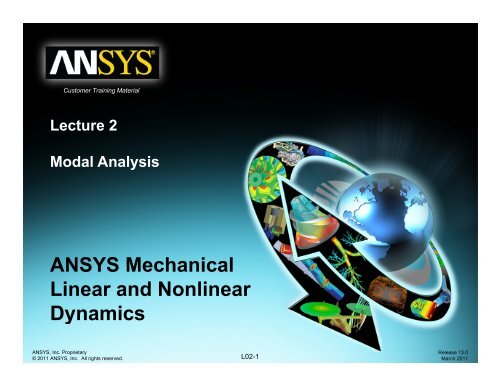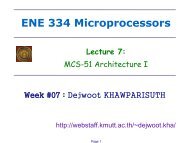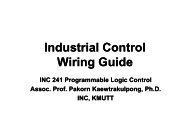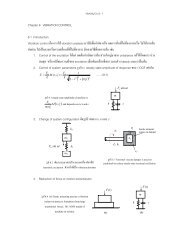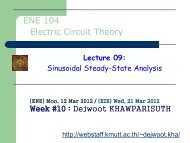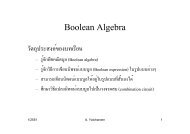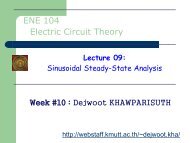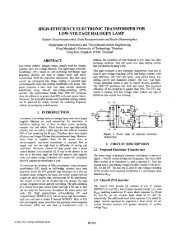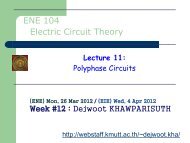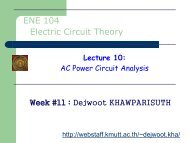ANSYS Mechanical Linear and Nonlinear ... - web page for staff
ANSYS Mechanical Linear and Nonlinear ... - web page for staff
ANSYS Mechanical Linear and Nonlinear ... - web page for staff
Create successful ePaper yourself
Turn your PDF publications into a flip-book with our unique Google optimized e-Paper software.
Customer Training Material<br />
LLecture t 2<br />
Modal Analysis y<br />
<strong>ANSYS</strong> <strong>Mechanical</strong><br />
<strong>Linear</strong> <strong>and</strong> <strong>Nonlinear</strong><br />
Dynamics<br />
<strong>ANSYS</strong>, Inc. Proprietary<br />
© 2011 <strong>ANSYS</strong>, Inc. All rights reserved.<br />
L02-1<br />
Release 13.0<br />
March 2011
<strong>ANSYS</strong> <strong>Mechanical</strong> <strong>Linear</strong> <strong>and</strong> <strong>Nonlinear</strong> Dynamics<br />
Modal Analysis<br />
Topics covered:<br />
A. Define modal analysis <strong>and</strong> its purpose.<br />
Customer Training Material<br />
B. Discuss associated concepts, terminology, <strong>and</strong> mode extraction<br />
methods methods.<br />
C. Learn how to do a modal analysis in Workbench.<br />
D. Work on one or two modal analysis exercises.<br />
<strong>ANSYS</strong>, Inc. Proprietary<br />
© 2011 <strong>ANSYS</strong>, Inc. All rights reserved.<br />
L02-2<br />
Release 13.0<br />
March 2011
<strong>ANSYS</strong> <strong>Mechanical</strong> <strong>Linear</strong> <strong>and</strong> <strong>Nonlinear</strong> Dynamics<br />
Description & Purpose<br />
Customer Training Material<br />
• A modal analysis is a technique used to determine the vibration<br />
characteristics of structures:<br />
– natural frequencies<br />
• at what frequencies the structure would tend to naturally vibrate<br />
– mode shapes<br />
• in what shape the structure would tend to vibrate at each frequency<br />
– mode participation factors<br />
• the amount of mass that participates in a given direction <strong>for</strong> each mode<br />
• MMost t ffundamental d t l of f all ll the th dynamic d i analysis l i types. t<br />
<strong>ANSYS</strong>, Inc. Proprietary<br />
© 2011 <strong>ANSYS</strong>, Inc. All rights reserved.<br />
L02-3<br />
Release 13.0<br />
March 2011
<strong>ANSYS</strong> <strong>Mechanical</strong> <strong>Linear</strong> <strong>and</strong> <strong>Nonlinear</strong> Dynamics<br />
Description & Purpose<br />
Customer Training Material<br />
Benefits of modal analysis<br />
• Allows the design to avoid resonant vibrations or to vibrate at a<br />
specified frequency (speaker box, <strong>for</strong> example).<br />
• Gives engineers an idea of how the design will respond to different<br />
types of dynamic loads.<br />
• Helps p in calculating g solution controls (time ( steps, p , etc.) ) <strong>for</strong> other<br />
dynamic analyses.<br />
Recommendation: Because a structure’s vibration characteristics<br />
determine how it responds to any type of dynamic load, it is generally<br />
recommended to per<strong>for</strong>m a modal analysis first be<strong>for</strong>e trying any other<br />
dynamic analysis.<br />
<strong>ANSYS</strong>, Inc. Proprietary<br />
© 2011 <strong>ANSYS</strong>, Inc. All rights reserved.<br />
L02-4<br />
Release 13.0<br />
March 2011
<strong>ANSYS</strong> <strong>Mechanical</strong> <strong>Linear</strong> <strong>and</strong> <strong>Nonlinear</strong> Dynamics<br />
Terminology<br />
• A “mode” refers to the pair of one<br />
natural frequency <strong>and</strong><br />
corresponding mode shape.<br />
– A structure can have any number of<br />
modes, up to the number of DOF in<br />
the model.<br />
<strong>ANSYS</strong>, Inc. Proprietary<br />
© 2011 <strong>ANSYS</strong>, Inc. All rights reserved.<br />
L02-5<br />
Customer Training Material<br />
mode 1<br />
← {φ} 1<br />
f f1 = 109 Hz<br />
mode 2<br />
← {φ} 2<br />
f 2 = 202 Hz<br />
mode 3<br />
← {φ} 3<br />
f 3 = 249 Hz<br />
Release 13.0<br />
March 2011
<strong>ANSYS</strong> <strong>Mechanical</strong> <strong>Linear</strong> <strong>and</strong> <strong>Nonlinear</strong> Dynamics<br />
Assumptions & Restrictions<br />
• The structure is linear (i.e. constant stiffness <strong>and</strong> mass).<br />
Customer Training Material<br />
• There is no damping.<br />
– Damped eigensolvers (MODOPT,DAMP or MODOPT,QRDAMP) may be<br />
accessed using Comm<strong>and</strong>s Objects, but will not be covered here.<br />
• The structure has no time varying <strong>for</strong>ces, displacements, pressures,<br />
or temperatures applied (free vibration).<br />
<strong>ANSYS</strong>, Inc. Proprietary<br />
© 2011 <strong>ANSYS</strong>, Inc. All rights reserved.<br />
L02-6<br />
Release 13.0<br />
March 2011
<strong>ANSYS</strong> <strong>Mechanical</strong> <strong>Linear</strong> <strong>and</strong> <strong>Nonlinear</strong> Dynamics<br />
Development<br />
• Start with the linear general equation of motion:<br />
[ M ]{ ]{ u u&<br />
& } + [ C C]{<br />
]{ u u&<br />
} + [ K]{<br />
]{ u } = { F }<br />
• Assume free vibrations, <strong>and</strong> ignore damping:<br />
• Assume harmonic motion:<br />
<strong>ANSYS</strong>, Inc. Proprietary<br />
© 2011 <strong>ANSYS</strong>, Inc. All rights reserved.<br />
} 0<br />
} 0<br />
[ M ]{} u&<br />
& + [ C]<br />
{} u&<br />
+ [ K ]{} u = { F}<br />
[ M ]{ ]{ u u&<br />
& } + [ K ]{ ]{ u } = { 0 }<br />
{ } { } ( )<br />
{} {} ( )<br />
{ } { } ( )<br />
i i<br />
i i<br />
u = φ i sin ωit<br />
+ θi<br />
u&<br />
= ω φ cos ω t + θ<br />
2 { u& & } = −ω<br />
{ φ}<br />
sin ( ω t + θ )<br />
i<br />
i<br />
L02-7<br />
i<br />
i<br />
Customer Training Material<br />
Release 13.0<br />
March 2011
<strong>ANSYS</strong> <strong>Mechanical</strong> <strong>Linear</strong> <strong>and</strong> <strong>Nonlinear</strong> Dynamics<br />
Development<br />
• Substitute <strong>and</strong> simplify<br />
−ω<br />
2<br />
i<br />
[ M ]{ ]{ u u&<br />
& } + [ K ]{ ]{ u } = { 0 }<br />
[ M ]{} φ i sin ( ωit<br />
+ θi<br />
) + [ K ]{} φ i sin ( ωit<br />
+ θi<br />
) = {} 0<br />
( 2<br />
ωω<br />
[ M ] + [ K ] ){ ){ φφ<br />
} = { 0 }<br />
− i<br />
i<br />
Customer Training Material<br />
• This equality is satisfied if {φ} i = 0 (trivial, implies no vibration) or if<br />
( [ ] 2<br />
K ] −ωω [ M ] ) = { 0 }<br />
det =<br />
K i<br />
• This is an eigenvalue problem which may be solved <strong>for</strong> up to n<br />
eigenvalues eigenvalues, ω 2<br />
i , <strong>and</strong> n eigenvectors eigenvectors, {φ}i {φ} i, where n is the number of<br />
DOF.<br />
<strong>ANSYS</strong>, Inc. Proprietary<br />
© 2011 <strong>ANSYS</strong>, Inc. All rights reserved.<br />
L02-8<br />
Release 13.0<br />
March 2011
<strong>ANSYS</strong> <strong>Mechanical</strong> <strong>Linear</strong> <strong>and</strong> <strong>Nonlinear</strong> Dynamics<br />
Extraction & Normalization<br />
• Note that the equation<br />
( [ ] 2<br />
−ωω [ M ] ) = { 0 }<br />
det M<br />
K i<br />
has one more unknown than equations; there<strong>for</strong>e, an additional<br />
equation is needed to find a solution. solution<br />
– The addition equation is provided by mode shape normalization.<br />
• Mode shapes can be normalized either to the mass matrix<br />
{ } T [ M ]{ φ}<br />
= 1<br />
φ<br />
i<br />
i<br />
Customer Training Material<br />
or to unity, where the largest component of the vector {φ} i is set to 1.<br />
• Workbench displays results normalized to the mass matrix.<br />
• Because of this normalization, only the shape of the DOF solution<br />
has real meaning.<br />
<strong>ANSYS</strong>, Inc. Proprietary<br />
© 2011 <strong>ANSYS</strong>, Inc. All rights reserved.<br />
L02-9<br />
Release 13.0<br />
March 2011
<strong>ANSYS</strong> <strong>Mechanical</strong> <strong>Linear</strong> <strong>and</strong> <strong>Nonlinear</strong> Dynamics<br />
Eigenvalues & Eigenvectors<br />
• The square roots of the eigenvalues<br />
are ω i, the structure’s natural<br />
circular frequencies (rad/s).<br />
• Natural frequencies fi can then<br />
calculated as f fi = ω ωi/2π /2π (cycles/s) (cycles/s).<br />
– It is the natural frequencies, f i in Hz,<br />
that are input by the user <strong>and</strong> output<br />
by Workbench.<br />
• The eigenvectors {φ} i represent the<br />
mode d shapes, h ii.e. th the shape h<br />
assumed by the structure when<br />
vibrating at frequency fi. <strong>ANSYS</strong>, Inc. Proprietary<br />
© 2011 <strong>ANSYS</strong>, Inc. All rights reserved.<br />
L02-10<br />
Customer Training Material<br />
mode 1<br />
← {φ} 1<br />
f f1 = 109 Hz<br />
mode 2<br />
← {φ} 2<br />
f 2 = 202 Hz<br />
mode 3<br />
← {φ} 3<br />
f 3 = 249 Hz<br />
Release 13.0<br />
March 2011
<strong>ANSYS</strong> <strong>Mechanical</strong> <strong>Linear</strong> <strong>and</strong> <strong>Nonlinear</strong> Dynamics<br />
Equation Solvers<br />
( [ ] 2<br />
−ω [ M ] ) = { 0}<br />
• The equation<br />
det K i<br />
can be solved using one of two solvers available in Workbench<br />
<strong>Mechanical</strong>:<br />
– Direct (Block Lanczos)<br />
Customer Training Material<br />
• To find many modes (about 40+) of large models.<br />
• Per<strong>for</strong>ms well when the model consists of shells or a combination of shells<br />
<strong>and</strong> solids.<br />
• Uses the Lanczos algorithm where the Lanczos recursion is per<strong>for</strong>med with a<br />
block of vectors. Uses the sparse matrix solver.<br />
– Iterative (PCG Lanczos)<br />
• To find few modes (up to about 100) of very large models (500,000+ DOFs).<br />
• Per<strong>for</strong>ms well when the lowest modes are sought <strong>for</strong> models that are<br />
ddominated i t d by b well-shaped ll h d 3-D 3 D solid lid elements. l t<br />
• Uses the Lanczos algorithm, combined with the PCG iterative solver.<br />
• In most cases cases, the Program Controlled option selects the optimal<br />
solver automatically.<br />
<strong>ANSYS</strong>, Inc. Proprietary<br />
© 2011 <strong>ANSYS</strong>, Inc. All rights reserved.<br />
L02-11<br />
Release 13.0<br />
March 2011
<strong>ANSYS</strong> <strong>Mechanical</strong> <strong>Linear</strong> <strong>and</strong> <strong>Nonlinear</strong> Dynamics<br />
Participation Factors (Solution In<strong>for</strong>mation)<br />
• The participation factors are calculated by<br />
γ =<br />
i<br />
T { φ}<br />
[ M ]{ D}<br />
i<br />
Customer Training Material<br />
where {D} is an assumed unit displacement spectrum in each of the global<br />
Cartesian directions <strong>and</strong> rotation about each of these axes.<br />
– This measures the amount of mass moving in each direction <strong>for</strong> each mode.<br />
– Th The “Ratio” “R ti ” iis simply i l another th list li t of f participation ti i ti factors, f t normalized li d to t the th<br />
largest.<br />
• The concept of participation factors will be important in later chapters.<br />
<strong>ANSYS</strong>, Inc. Proprietary<br />
© 2011 <strong>ANSYS</strong>, Inc. All rights reserved.<br />
L02-12<br />
Release 13.0<br />
March 2011
<strong>ANSYS</strong> <strong>Mechanical</strong> <strong>Linear</strong> <strong>and</strong> <strong>Nonlinear</strong> Dynamics<br />
Participation Factors (Solution In<strong>for</strong>mation)<br />
Customer Training Material<br />
• A high value in a direction indicates that the mode will be excited by <strong>for</strong>ces in<br />
that direction.<br />
<strong>ANSYS</strong>, Inc. Proprietary<br />
© 2011 <strong>ANSYS</strong>, Inc. All rights reserved.<br />
mode 1 mode 3 mode 5<br />
L02-13<br />
Release 13.0<br />
March 2011
<strong>ANSYS</strong> <strong>Mechanical</strong> <strong>Linear</strong> <strong>and</strong> <strong>Nonlinear</strong> Dynamics<br />
Effective Mass (Solution In<strong>for</strong>mation)<br />
• Also printed out is the effective mass.<br />
2<br />
γ i<br />
2<br />
T<br />
M eff , i = = γγ<br />
i , if { φφ<br />
} i [ M ]{ ]{ φφ<br />
} i = 1<br />
T { φ } [ M ]{ ]{ φ }<br />
i<br />
i<br />
Customer Training Material<br />
• Ideally, the sum of the effective masses in each direction should equal total<br />
mass of structure structure, but will depend on the number of modes extracted. extracted<br />
• The ratio of effective mass to total mass can be useful <strong>for</strong> determining<br />
whether or not a sufficient number of modes have been extracted.<br />
<strong>ANSYS</strong>, Inc. Proprietary<br />
© 2011 <strong>ANSYS</strong>, Inc. All rights reserved.<br />
L02-14<br />
Release 13.0<br />
March 2011
<strong>ANSYS</strong> <strong>Mechanical</strong> <strong>Linear</strong> <strong>and</strong> <strong>Nonlinear</strong> Dynamics<br />
Contact Regions<br />
Customer Training Material<br />
• Contact regions are available in modal analysis; however, since this<br />
is a purely linear analysis, contact behavior will differ <strong>for</strong> the<br />
nonlinear contact types, as shown below:<br />
Contact Type Static Analysis<br />
<strong>Linear</strong> Dynamic Analysis<br />
Initially Touching Inside Pinball Region<br />
Outside Pinball<br />
Region g<br />
Bonded Bonded Bonded Bonded Free<br />
No Separation No Separation No Separation No Separation Free<br />
Rough Rough Bonded Free Free<br />
Frictionless Frictionless No Separation Free Free<br />
Frictional Frictional<br />
μ = 0, No Separation<br />
μ > 0, Bonded<br />
Free Free<br />
• Contact behavior will reduce to its linear counterparts.<br />
– It is generally recommended, however, not to use a nonlinear contact<br />
type in a linear-dynamic analysis<br />
<strong>ANSYS</strong>, Inc. Proprietary<br />
© 2011 <strong>ANSYS</strong>, Inc. All rights reserved.<br />
L02-15<br />
Release 13.0<br />
March 2011
<strong>ANSYS</strong> <strong>Mechanical</strong> <strong>Linear</strong> <strong>and</strong> <strong>Nonlinear</strong> Dynamics<br />
Unconstrained Systems<br />
Customer Training Material<br />
• An unconstrained system is one that has no constraints or supports<br />
<strong>and</strong> can move as a rigid body in at least one direction.<br />
– Rigid-body motion can be considered to be a mode of oscillation with<br />
zero frequency.<br />
– In practice, these modes may not have a frequency of exactly zero.<br />
“rigid-body”<br />
or<br />
“zero” zero modes<br />
• Note that a well-connected system can have at most six rigid-body<br />
modes.<br />
– Obt Obtaining i i more than th six i rigid-body i id b d modes d may indicate i di t that th t assemblies bli<br />
are not well connected.<br />
<strong>ANSYS</strong>, Inc. Proprietary<br />
© 2011 <strong>ANSYS</strong>, Inc. All rights reserved.<br />
L02-16<br />
Release 13.0<br />
March 2011
Customer Training Material<br />
MModal d l<br />
Prestress Effects<br />
<strong>ANSYS</strong> <strong>Mechanical</strong><br />
<strong>Linear</strong> <strong>and</strong> <strong>Nonlinear</strong><br />
Dynamics<br />
<strong>ANSYS</strong>, Inc. Proprietary<br />
© 2011 <strong>ANSYS</strong>, Inc. All rights reserved.<br />
L02-17<br />
Release 13.0<br />
March 2011
<strong>ANSYS</strong> <strong>Mechanical</strong> <strong>Linear</strong> <strong>and</strong> <strong>Nonlinear</strong> Dynamics<br />
Prestress Effects<br />
Customer Training Material<br />
• A prestressed modal analysis can be used to calculate the<br />
frequencies <strong>and</strong> mode shapes of a prestressed structure, such as a<br />
spinning turbine blade.<br />
– The prestress influences the stiffness of the structure through the stressstiffening<br />
matrix contribution.<br />
<strong>ANSYS</strong>, Inc. Proprietary<br />
© 2011 <strong>ANSYS</strong>, Inc. All rights reserved.<br />
L02-18<br />
Release 13.0<br />
March 2011
<strong>ANSYS</strong> <strong>Mechanical</strong> <strong>Linear</strong> <strong>and</strong> <strong>Nonlinear</strong> Dynamics<br />
Prestress Effects<br />
Customer Training Material<br />
• In free vibration with prestress analyses, two solutions are required.<br />
– A linear static analysis is initially per<strong>for</strong>med:<br />
[ K K]{<br />
]{ u } = { F } → [ σ ]<br />
– Based on the stress state [σ] from the static analysis, a stress stiffness<br />
matrix [S] is calculated (see Theory Reference <strong>for</strong> details):<br />
[ σ ] → [ S]<br />
– The free vibration with pre-stress analysis is then solved, including the<br />
[S] term:<br />
( 2 [ K + S ] −ω<br />
[ M ] ){ ){ φ } = { 0 }<br />
S K φ ω<br />
+ i i M<br />
• Note that the prestress only affects the stiffness of the system.<br />
– ie i.e. the static prestress will not be added to the modal stress<br />
<strong>ANSYS</strong>, Inc. Proprietary<br />
© 2011 <strong>ANSYS</strong>, Inc. All rights reserved.<br />
L02-19<br />
Release 13.0<br />
March 2011
<strong>ANSYS</strong> <strong>Mechanical</strong> <strong>Linear</strong> <strong>and</strong> <strong>Nonlinear</strong> Dynamics<br />
Prestress Effects<br />
Customer Training Material<br />
• <strong>Mechanical</strong> employs the new MAPDL linear perturbation technique<br />
<strong>for</strong> all prestressed eigenvalue analysis<br />
• <strong>Linear</strong> perturbation supports<br />
– Large deflection, nonlinear pre-stress<br />
– Prestressed modal from any y restart ppoint<br />
– H<strong>and</strong>ling true contact status from the static analysis<br />
– Cyclic symmetry<br />
[K T [K T<br />
i ]<br />
• Any time point from a static or<br />
transient structural analysis<br />
can be perturbed. p<br />
• Uses global tangent stiffness<br />
matrix [K i T ] from the time point.<br />
• Restart files must be available.<br />
<strong>ANSYS</strong>, Inc. Proprietary<br />
© 2011 <strong>ANSYS</strong>, Inc. All rights reserved.<br />
L02-20<br />
t i<br />
Release 13.0<br />
March 2011
<strong>ANSYS</strong> <strong>Mechanical</strong> <strong>Linear</strong> <strong>and</strong> <strong>Nonlinear</strong> Dynamics<br />
Prestress Effects<br />
• Tangent Stiffness matrix<br />
K = K + K +<br />
T<br />
i<br />
+<br />
Mat<br />
i<br />
SpinSoftening<br />
i<br />
Contact<br />
i<br />
K +<br />
• Material Stiffness [K i Mat ]<br />
K<br />
K<br />
LoadStiffness<br />
i<br />
StressStiffness<br />
i<br />
[K i T ]<br />
Customer Training Material<br />
– For nonlinear materials, only the linear portion is used<br />
– For hyperelastic materials, the tangent material properties at the point of restart<br />
are used<br />
• Stress Stiffening [K i StressStiffness ] / Spin softening [Ki SpinSoftening ]<br />
– Effects included automatically in large deflection analyses<br />
• Contact stiffness [K i Contact ]<br />
– Contact behavior can be changed prior to the modal analysis<br />
– (more on this later)<br />
<strong>ANSYS</strong>, Inc. Proprietary<br />
© 2011 <strong>ANSYS</strong>, Inc. All rights reserved.<br />
L02-21<br />
t i<br />
Release 13.0<br />
March 2011
Customer Training Material<br />
MModal d l<br />
Procedure<br />
<strong>ANSYS</strong> <strong>Mechanical</strong><br />
<strong>Linear</strong> <strong>and</strong> <strong>Nonlinear</strong><br />
Dynamics<br />
<strong>ANSYS</strong>, Inc. Proprietary<br />
© 2011 <strong>ANSYS</strong>, Inc. All rights reserved.<br />
L02-22<br />
Release 13.0<br />
March 2011
<strong>ANSYS</strong> <strong>Mechanical</strong> <strong>Linear</strong> <strong>and</strong> <strong>Nonlinear</strong> Dynamics<br />
Procedure<br />
• Drop a Modal (<strong>ANSYS</strong>) system into the project schematic.<br />
<strong>ANSYS</strong>, Inc. Proprietary<br />
© 2011 <strong>ANSYS</strong>, Inc. All rights reserved.<br />
L02-23<br />
Customer Training Material<br />
Release 13.0<br />
March 2011
<strong>ANSYS</strong> <strong>Mechanical</strong> <strong>Linear</strong> <strong>and</strong> <strong>Nonlinear</strong> Dynamics<br />
Procedure<br />
• Create new geometry, or link to<br />
existing geometry.<br />
<strong>ANSYS</strong>, Inc. Proprietary<br />
© 2011 <strong>ANSYS</strong>, Inc. All rights reserved.<br />
L02-24<br />
Customer Training Material<br />
• Edit the Model cell to bring up the<br />
<strong>Mechanical</strong> application.<br />
Release 13.0<br />
March 2011
<strong>ANSYS</strong> <strong>Mechanical</strong> <strong>Linear</strong> <strong>and</strong> <strong>Nonlinear</strong> Dynamics<br />
Preprocessing<br />
• Verify materials, connections, <strong>and</strong> mesh settings.<br />
– This was covered in Workbench <strong>Mechanical</strong> Intro.<br />
<strong>ANSYS</strong>, Inc. Proprietary<br />
© 2011 <strong>ANSYS</strong>, Inc. All rights reserved.<br />
L02-25<br />
Customer Training Material<br />
Release 13.0<br />
March 2011
<strong>ANSYS</strong> <strong>Mechanical</strong> <strong>Linear</strong> <strong>and</strong> <strong>Nonlinear</strong> Dynamics<br />
Preprocessing<br />
• Optional: Specify “Cyclic Region”<br />
– Matched mesh will be created at the low-high regions<br />
<strong>ANSYS</strong>, Inc. Proprietary<br />
© 2011 <strong>ANSYS</strong>, Inc. All rights reserved.<br />
L02-26<br />
Customer Training Material<br />
Select Harmonic<br />
Indices of interest in<br />
Analysis Settings<br />
Release 13.0<br />
March 2011
<strong>ANSYS</strong> <strong>Mechanical</strong> <strong>Linear</strong> <strong>and</strong> <strong>Nonlinear</strong> Dynamics<br />
Preprocessing<br />
• Add supports to the model.<br />
– Displacement constrains must have a magnitude of zero.<br />
<strong>ANSYS</strong>, Inc. Proprietary<br />
© 2011 <strong>ANSYS</strong>, Inc. All rights reserved.<br />
L02-27<br />
Customer Training Material<br />
Release 13.0<br />
March 2011
<strong>ANSYS</strong> <strong>Mechanical</strong> <strong>Linear</strong> <strong>and</strong> <strong>Nonlinear</strong> Dynamics<br />
Solution Settings<br />
• Choose the number of modes to<br />
extract.<br />
<strong>ANSYS</strong>, Inc. Proprietary<br />
© 2011 <strong>ANSYS</strong>, Inc. All rights reserved.<br />
L02-28<br />
Customer Training Material<br />
• If needed, upper <strong>and</strong> lower bounds<br />
on frequency may be specified to<br />
extract the modes within a specified<br />
range.<br />
Release 13.0<br />
March 2011
<strong>ANSYS</strong> <strong>Mechanical</strong> <strong>Linear</strong> <strong>and</strong> <strong>Nonlinear</strong> Dynamics<br />
Solution Settings<br />
• If the Program-Controlled solver<br />
selection is not appropriate, the<br />
solver type can be changed to<br />
either Direct or Iterative.<br />
<strong>ANSYS</strong>, Inc. Proprietary<br />
© 2011 <strong>ANSYS</strong>, Inc. All rights reserved.<br />
L02-29<br />
Customer Training Material<br />
• Stress <strong>and</strong> strain results may be<br />
turned on under Output Controls.<br />
Release 13.0<br />
March 2011
<strong>ANSYS</strong> <strong>Mechanical</strong> <strong>Linear</strong> <strong>and</strong> <strong>Nonlinear</strong> Dynamics<br />
Postprocessing<br />
• Total-de<strong>for</strong>mation results may be<br />
quickly inserted by highlighting<br />
multiple rows in the tabular view or<br />
histogram view. view<br />
<strong>ANSYS</strong>, Inc. Proprietary<br />
© 2011 <strong>ANSYS</strong>, Inc. All rights reserved.<br />
L02-30<br />
Customer Training Material<br />
Release 13.0<br />
March 2011
<strong>ANSYS</strong> <strong>Mechanical</strong> <strong>Linear</strong> <strong>and</strong> <strong>Nonlinear</strong> Dynamics<br />
Postprocessing<br />
Customer Training Material<br />
• If stress/strain were requested, these results may also be access from the<br />
Solution Toolbar.<br />
<strong>ANSYS</strong>, Inc. Proprietary<br />
© 2011 <strong>ANSYS</strong>, Inc. All rights reserved.<br />
L02-31<br />
Release 13.0<br />
March 2011
<strong>ANSYS</strong> <strong>Mechanical</strong> <strong>Linear</strong> <strong>and</strong> <strong>Nonlinear</strong> Dynamics<br />
Postprocessing<br />
Customer Training Material<br />
• If cyclic symmetry was activated, results will be automatically exp<strong>and</strong>ed.<br />
Cyclic Expansion<br />
Harmonic<br />
Index<br />
Control<br />
<strong>ANSYS</strong>, Inc. Proprietary<br />
© 2011 <strong>ANSYS</strong>, Inc. All rights reserved.<br />
Interactive Frequency-Spectrum Display<br />
L02-32<br />
Modes listed<br />
by Harmonic<br />
Indices<br />
Release 13.0<br />
March 2011
Customer Training Material<br />
MModal d l<br />
Prestressed Procedure<br />
<strong>ANSYS</strong> <strong>Mechanical</strong><br />
<strong>Linear</strong> <strong>and</strong> <strong>Nonlinear</strong><br />
Dynamics<br />
<strong>ANSYS</strong>, Inc. Proprietary<br />
© 2011 <strong>ANSYS</strong>, Inc. All rights reserved.<br />
L02-33<br />
Release 13.0<br />
March 2011
<strong>ANSYS</strong> <strong>Mechanical</strong> <strong>Linear</strong> <strong>and</strong> <strong>Nonlinear</strong> Dynamics<br />
Procedure<br />
• The procedure to do a prestressed<br />
modal analysis is essentially the<br />
same as a regular modal analysis,<br />
except that you first need to<br />
prestress the structure by doing a<br />
static analysis.<br />
• The static analysis results in a<br />
stressed structure, which is used as<br />
the initial condition <strong>for</strong> the modal<br />
analysis. l i<br />
<strong>ANSYS</strong>, Inc. Proprietary<br />
© 2011 <strong>ANSYS</strong>, Inc. All rights reserved.<br />
L02-34<br />
Customer Training Material<br />
Release 13.0<br />
March 2011
<strong>ANSYS</strong> <strong>Mechanical</strong> <strong>Linear</strong> <strong>and</strong> <strong>Nonlinear</strong> Dynamics<br />
Procedure<br />
• Drop a Static Structural (<strong>ANSYS</strong>) system into the project schematic.<br />
<strong>ANSYS</strong>, Inc. Proprietary<br />
© 2011 <strong>ANSYS</strong>, Inc. All rights reserved.<br />
L02-35<br />
Customer Training Material<br />
Release 13.0<br />
March 2011
<strong>ANSYS</strong> <strong>Mechanical</strong> <strong>Linear</strong> <strong>and</strong> <strong>Nonlinear</strong> Dynamics<br />
Procedure<br />
• Drop a Modal (<strong>ANSYS</strong>) system onto<br />
the Solution cell of the Modal<br />
system.<br />
<strong>ANSYS</strong>, Inc. Proprietary<br />
© 2011 <strong>ANSYS</strong>, Inc. All rights reserved.<br />
L02-36<br />
Customer Training Material<br />
• Note the circular-ended connector,<br />
indicating a data transfer from the<br />
Static to the Modal analysis.<br />
Release 13.0<br />
March 2011
<strong>ANSYS</strong> <strong>Mechanical</strong> <strong>Linear</strong> <strong>and</strong> <strong>Nonlinear</strong> Dynamics<br />
Procedure<br />
• Create new geometry, or link to<br />
existing geometry.<br />
<strong>ANSYS</strong>, Inc. Proprietary<br />
© 2011 <strong>ANSYS</strong>, Inc. All rights reserved.<br />
L02-37<br />
Customer Training Material<br />
• Edit the Model cell to bring up the<br />
<strong>Mechanical</strong> application.<br />
Release 13.0<br />
March 2011
<strong>ANSYS</strong> <strong>Mechanical</strong> <strong>Linear</strong> <strong>and</strong> <strong>Nonlinear</strong> Dynamics<br />
Static: Preprocessing<br />
Customer Training Material<br />
• In the Static Structural system, insert the loads <strong>and</strong> supports that will cause<br />
the prestressed-state to occur.<br />
<strong>ANSYS</strong>, Inc. Proprietary<br />
© 2011 <strong>ANSYS</strong>, Inc. All rights reserved.<br />
L02-38<br />
Release 13.0<br />
March 2011
<strong>ANSYS</strong> <strong>Mechanical</strong> <strong>Linear</strong> <strong>and</strong> <strong>Nonlinear</strong> Dynamics<br />
Preprocessing<br />
• Optional: Specify “Cyclic Region”<br />
– Matched mesh will be created at the low-high regions<br />
<strong>ANSYS</strong>, Inc. Proprietary<br />
© 2011 <strong>ANSYS</strong>, Inc. All rights reserved.<br />
L02-39<br />
Customer Training Material<br />
Select Harmonic<br />
Indices of interest in<br />
Analysis Settings<br />
Release 13.0<br />
March 2011
<strong>ANSYS</strong> <strong>Mechanical</strong> <strong>Linear</strong> <strong>and</strong> <strong>Nonlinear</strong> Dynamics<br />
Static: Analysis Settings<br />
Customer Training Material<br />
• Setup restart controls of parent static structural analysis according<br />
to requirements.<br />
– Default is to retain a restart point <strong>for</strong> the last substep of the last load step.<br />
– Recall: any substep can be perturbed, providing there is a restart point.<br />
<strong>ANSYS</strong>, Inc. Proprietary<br />
© 2011 <strong>ANSYS</strong>, Inc. All rights reserved.<br />
L02-40<br />
Release 13.0<br />
March 2011
<strong>ANSYS</strong> <strong>Mechanical</strong> <strong>Linear</strong> <strong>and</strong> <strong>Nonlinear</strong> Dynamics<br />
Static: Postprocessing<br />
<strong>ANSYS</strong>, Inc. Proprietary<br />
© 2011 <strong>ANSYS</strong>, Inc. All rights reserved.<br />
L02-41<br />
Customer Training Material<br />
• Review the static results be<strong>for</strong>e<br />
proceeding.<br />
Release 13.0<br />
March 2011
<strong>ANSYS</strong> <strong>Mechanical</strong> <strong>Linear</strong> <strong>and</strong> <strong>Nonlinear</strong> Dynamics<br />
Analysis Settings: Prestress Environment<br />
• In the modal analysis, user can specify<br />
which restart point from the static<br />
analysis will be used as the prestress<br />
environment.<br />
• This can be specified by either<br />
(1) End of load step<br />
(2) Time<br />
<strong>ANSYS</strong>, Inc. Proprietary<br />
© 2011 <strong>ANSYS</strong>, Inc. All rights reserved.<br />
L02-42<br />
Customer Training Material<br />
Release 13.0<br />
March 2011
<strong>ANSYS</strong> <strong>Mechanical</strong> <strong>Linear</strong> <strong>and</strong> <strong>Nonlinear</strong> Dynamics<br />
Analysis Settings: Contact Status<br />
• The user also has some control over the<br />
contact status.<br />
• Available options are:<br />
(1) Use True Status<br />
– Use the status at the restart point.<br />
(2) Force Sticking<br />
– For frictional contact with mu>0, set<br />
sliding elements to sticking.<br />
(3) Force Bonded<br />
– Use bonded contact <strong>for</strong> all contact<br />
pairs that are closed.<br />
<strong>ANSYS</strong>, Inc. Proprietary<br />
© 2011 <strong>ANSYS</strong>, Inc. All rights reserved.<br />
L02-43<br />
Customer Training Material<br />
Release 13.0<br />
March 2011
<strong>ANSYS</strong> <strong>Mechanical</strong> <strong>Linear</strong> <strong>and</strong> <strong>Nonlinear</strong> Dynamics<br />
Postprocessing<br />
Customer Training Material<br />
• The modal results may be reviewed as described in the previous section.<br />
<strong>ANSYS</strong>, Inc. Proprietary<br />
© 2011 <strong>ANSYS</strong>, Inc. All rights reserved.<br />
L02-44<br />
Release 13.0<br />
March 2011
<strong>ANSYS</strong> <strong>Mechanical</strong> <strong>Linear</strong> <strong>and</strong> <strong>Nonlinear</strong> Dynamics<br />
Postprocessing<br />
Customer Training Material<br />
• Note that the prestressed state increased the frequencies of this structure.<br />
– e.g. the first mode in this example increased from 108.3 Hz to 274.6 Hz<br />
Not Prestressed Prestressed<br />
• A prestress may not always increase the natural frequencies; a compressive<br />
load will decrease the frequencies.<br />
– In fact, fact a sufficiently-high compressive load will result in a natural frequency of<br />
zero, effectively replicating the results of a buckling analysis.<br />
<strong>ANSYS</strong>, Inc. Proprietary<br />
© 2011 <strong>ANSYS</strong>, Inc. All rights reserved.<br />
L02-45<br />
Release 13.0<br />
March 2011
<strong>ANSYS</strong> <strong>Mechanical</strong> <strong>Linear</strong> <strong>and</strong> <strong>Nonlinear</strong> Dynamics<br />
D. Workshop - Modal Analysis<br />
This workshop consists of two problems:<br />
1. Modal analysis of a plate with a hole<br />
Customer Training Material<br />
– A step-by-step description of how to do the analysis.<br />
– You may choose to run this problem yourself, or your instructor may<br />
show it as a demonstration.<br />
(WS2A: Modal Analysis - Plate with a Hole).<br />
22. Pre-stressed Pre stressed Modal analysis of a model airplane wing<br />
– This is left as an exercise to you.<br />
(WS2B: Modal Analysis - Model Airplane Wing).<br />
<strong>ANSYS</strong>, Inc. Proprietary<br />
© 2011 <strong>ANSYS</strong>, Inc. All rights reserved.<br />
L02-46<br />
Release 13.0<br />
March 2011


